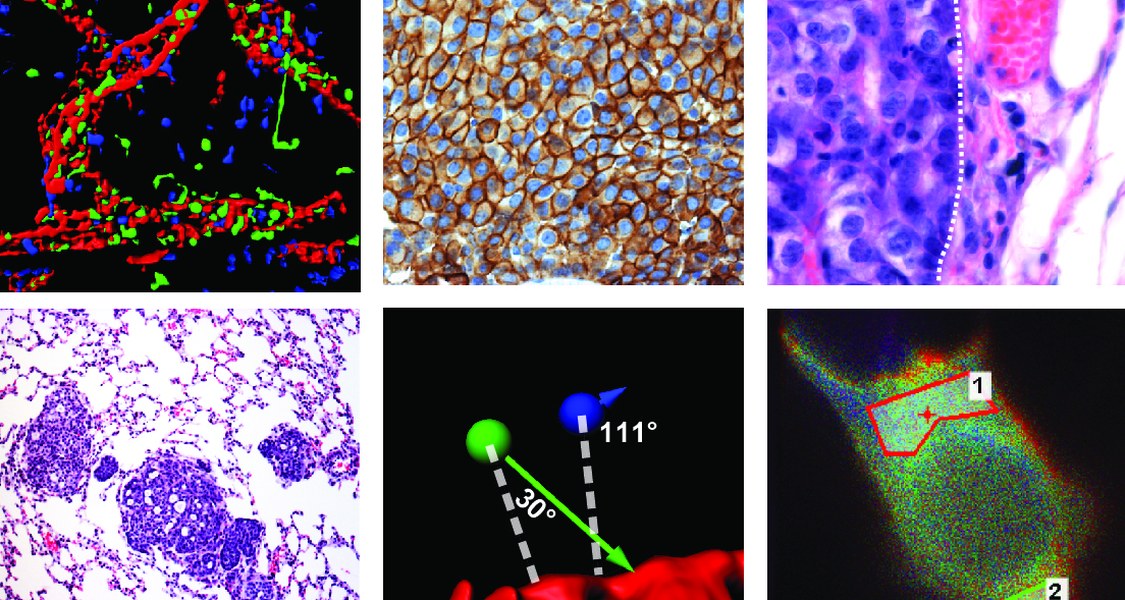Main Content
Epithelial Cancers

One of our major research interests is on the role of plexins in cancer. We could show that Plexin-B1 interacts with the oncogenic receptor tyrosine kinase ErbB-2, and that this interaction is of central importance for the progression of ErbB-2-overexpressing breast cancer. Plexin-B1 is expressed on breast cancer cells, and is phosphorylated and activated by overexpressed ErbB-2. This phosphorylation and activation of Plexin-B1 by ErbB-2 results in the activation of the pro-invasive small GTPases RhoA and RhoC, which promotes invasiveness of breast cancer cells in vitro and plays a decisive role for metastasis in vivo. We could also detect an ErbB-2-dependent phosphorylation of Plexin-B1 in tumor biopsies of breast cancer patients. Moreover, a systematic analysis of human microarray data showed a correlation of high Plexin-B1 expression levels with poor patient prognosis. Newly generated anti-Plexin-B1 antibodies, which block the interaction of Plexin-B1 and ErbB-2, inhibited the invasiveness of ErbB-2-overexpressing breast and ovarian cancer cell lines in vitro.
We hypothesized that particular semaphorins could also serve as receptors, rather than ligands, and signal in a reverse manner. This would allow the semaphorin-plexin system to signal bidirectionally. Indeed, we could characterize a reverse signaling pathway - with Plexin-B1 acting as a ligand and Semaphorin 4A (Sema4A) acting as a receptor - that controls cancer cell migration and invasion: by employing a combination of mass spectrometry analyses and siRNA screens, we identified the cell polarity protein Scrib to be an effector of Sema4A. The binding of Plexin-B1 to Sema4A promotes the interaction of Sema4A with Scrib, thereby removing Scrib from its complex with the Rac/Cdc42 exchange factor (GEF) βPIX and reducing the activity of the small GTPases Rac1 and Cdc42. This mechanism operates not only in various types of cancer cells but also in dendritic cells, which migrate towards a Plexin-B1 gradient in a Sema4A-dependent manner.
In current projects, we are systematically characterizing the molecular communication networks in the tumor microenvironment, and testing their functional relevance for tumor progression and metastasis. In addition to breast cancer, we focus on a second gynecologic malignancy, ovarian cancer. A hallmark of ovarian cancer is its very early metastatic spread via the peritoneal fluid. In addition to cancer cells, this peritoneal fluid contains functionally highly relevant tumor-associated macrophages and tumor-associated T cells. To unravel the signaling mechanisms, which convey communication between these different cell types, we performed comprehensive analyses of the proteomes and transcriptomes of primary human ovarian cancer cells, tumor-associated macrophages, and tumor-associated T cells isolated from the peritoneal fluid of ovarian cancer patients. We could identify intercellular signaling pathways, which correlate with patient prognosis. Our results suggest that the semaphorin-plexin system and other ligand-receptor systems play a central role in the communication between the different cell types in the ovarian cancer tumor microenvironment, and could represent promising pharmacological targets for the treatment of ovarian cancer.
Selected publications:
- Jiang C, Javed A, Kaiser L, Nava MM, Zhao D, Brandt DT, Fernández-Baldovinos J, Zhou L, Höß C, Sawmynaden K, Oleksy A, Matthews D, Weinstein LS, Gröne HJ, Niessen CM, Offermanns S, Wickström SA, Worzfeld T. (2020).
Mechanochemical control of epidermal stem cell divisions by B-plexins.
bioRxiv. doi: https://doi.org/10.1101/2020.04.30.070359. - Worzfeld, T., Finkernagel, F., Reinartz, S., Konzer, A., Adhikary, T., Nist, A., Stiewe, T., Wagner, U., Looso, M., Graumann, J., Müller, R. (2018).
Proteotranscriptomics Reveal Signaling Networks in the Ovarian Cancer Microenvironment.
Molecular and Cellular Proteomics 17, 270-289 - Sun, T., Yang, L., Kaur, H., Pestel, J., Looso, M., Nolte, H., Krasel, C., Heil, D., Krishnan, R.K., Santoni, M.J., Borg, J.P., Bünemann, M., Offermanns, S., Swiercz, J.M., Worzfeld, T. (2017).
A reverse signaling pathway downstream of Sema4A controls cell migration via Scrib.
Journal of Cell Biology 216, 199-215 - Worzfeld, T., Swiercz, J.M., Looso, M., Straub, B.K., Sivaraj, K.K., Offermanns, S. (2012).
ErbB-2 signals through Plexin-B1 to promote breast cancer metastasis.
Journal of Clinical Investigation 122, 1296-1305